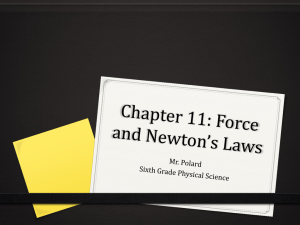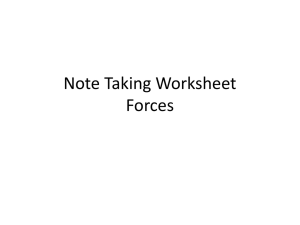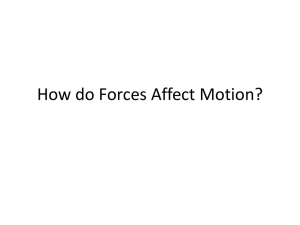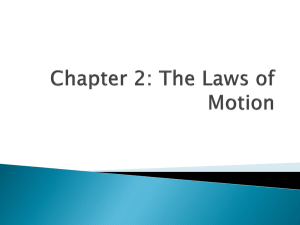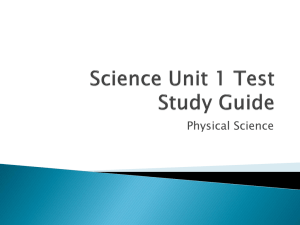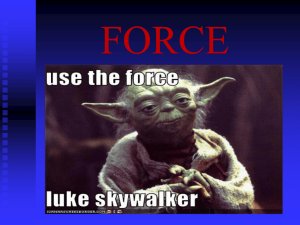Forces
advertisement
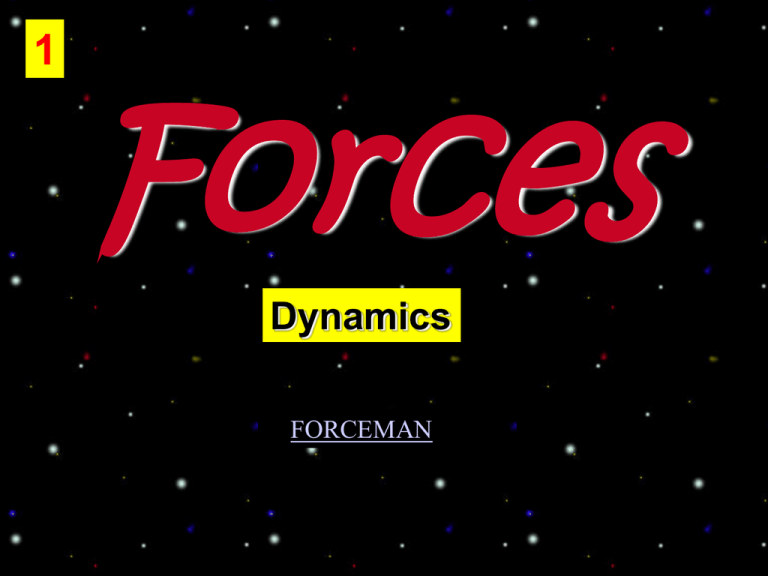
1 Forces Dynamics FORCEMAN 2 What causes things to move? • Forces • What is a force? – A push or a pull that one body exerts on another. 3 •Balanced No change in motion 4 5 Unbalanced • If the forces acting on a body are "unbalanced" this means that there is a "net" or "resultant" force. • The body will do one of the following: 1. Speed Up 2. Slow Down 3. Change the Direction of its Motion • In other words • The Body will Accelerate 6 7 Newtons • SI unit of force is the Newton (N). • Defined as the amount of force that when acting on a 1 kg object produces an acceleration of 1m/s2. • Therefore, 1N = 1 kg • m s2 8 Newton’s First Law 9 Newton’s First Law 10 Newton’s First Law • An object at rest stays at rest, and an object in motion stays in motion unless acted upon by a net external force. • What do you mean by “Net Force”? • Net means: Final Sum, so net external force is the sum of all the forces acting on the object. 11 Newton’s First Law •Newton’s First Law is also called the Law of Inertia. • Inertia is the tendency of an object to resist any change in its motion. 12 Why does the ladder continue to move? Inertia! 13 Why does the person continue to move? Inertia! Clip 14 Newton’s Second Law • The acceleration of an object is directly proportional to the net external force acting on the object and inversely proportional to the object’s mass. •F=ma • Clip 15 16 Newton's 2nd Law of Motion: •Force = mass x acceleration F = (ma) Mass is in kg 2 Acceleration is in m/s 2 Force is in kg x m/ s (or N) Force Problems: 17 What force is needed to give an object with a mass of 25.0 kg an acceleration of 15.0 m/s2 ? Formula Given: m = 25.0 kg a = 15.0 m/sec² F = ma Unknown: F=? F = (25 kg)(15 m/sec²) F = 375 kg•m/sec² = 375 N NewtoN’s Third Law 34 Newton’s Third Law of Motion …to every action force there is an equal and opposite reaction force 35 ActionReaction forces act on different objects 36 Review Newton’s Laws Clip 18 Forces that oppose motion 1 9 Forces that oppose motion Friction Song 1 Friction Song 2 Forces that oppose motion -Air resistance is the force air exerts on a moving object 20 • • Friction What Causes Friction? Microscopic, electrostatic interactions between contacting surfaces • Three types of friction: 1. Static Friction 2. Sliding Friction 3. Rolling Friction 21 Types of Friction Types of friction: 1. Static – force required to overcome inertia of a stationary object 22 Static Friction (FS) 23Types of Friction (cont’.) 2. Sliding – force required to keep an object sliding at a constant speed 3. Rolling – force required to keep an object rolling at a To decrease friction, surfaces can be lubricated with a liquid suchconstant as oil. speed FRICTION LAB 24 CLIP The amount of force required to overcome static friction is always greater than the force required to overcome sliding or rolling friction. 25 GRAVITY!! • The force of gravity is an attractive force between objects. • The amount of GRAVITATIONAL FORCE between objects depends upon their: • 1- Masses (greater mass means more gravity) • 2- Distance apart (greater distance means less gravity) *All objects fall toward the earth at the same rate of acceleration, regardless of their masses! 26 Calculating the Gravitational Force 27 Gravitation 28 Weightlessness Gravity in Space Moon Moon Hammer & Feather 29Free fall and Terminal Velocity • The opposing force of air resistance increases with speed. • Objects accelerate towards the Earth until the force of gravity is cancelled or balanced by this air resistance. • This is the highest speed an object can reach. • Different objects have different terminal velocities. 30 Weight and Gravity W =m x g BECAUSE IT’S A FORCE! 31 32 Weight • When the mass of an object and the acceleration due to gravity are known, the weight of an object can be calculated. Ex. Mass = 100kg Acc.= 9.81 m/s2 Weight = 981 N 33 Example Problem • What is your weight if your mass 4.52 kilograms? Given: Unknown: m = 4.52 kg W=? g = a = 9.8 m/sec² Formula: W = mg W = (4.52kg)(9.8 m/sec²) W = 44.296 kg•m/sec² = 44.296 N 37 Projectile Motion Projectiles follow a curved path because gravitational pull. of the Earth’s They have 2 types of motion that are independent of each other: 1. Horizontal motion 2. Vertical motion 38 Projectile Motion Which will hit the ground first? A ball that is dropped straight down or a ball that is “shot” out horizontally? * An object launched horizontally will land on the ground at the same time as an object simply dropped from the same height!!!! Another Example of Projectile Motion 39 40 Circular Motion • Roller Coaster Clip An object moving in a circular motion at the same speed is accelerating toward the center because its direction is constantly changing. Centripetal acceleration is acceleration toward the center of a curved path. 'Centripetal' comes from the Latin word for 'center seeking' Centrifugal 'force' is really a function of the inertia of the object being pushed into a circle. It is not really a force at all, it is simply the tendency of an object to go in a straight line. only centripetal is the real force 41 Circular Motion cont.’ • Centripetal force is the force that causes a moving object to move in a curved path Without a centripetal force, an object in motion continues along a straight-line path. With a centripetal force, an object in motion will be accelerated and change its direction. 42 43 How do rollercoasters work!?! Amusement Park Forces

